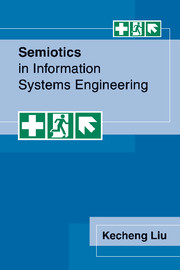Book contents
- Frontmatter
- Contents
- Preface
- 1 Introduction
- Part one Semiotic framework and methods
- 2 Understanding semiotics
- 3 A semiotic framework for information systems
- 4 A semiotic approach to information systems development
- 5 Knowledge representation and information analysis
- 6 Semantic Analysis
- 7 Pragmatics and communication
- 8 The social layer: modelling organisations as information systems
- Part two Applications
- Appendix A Semantic templates and surrogate specification
- Appendix B LEGOL applications in the CRIS case
- Bibliography
- Index
2 - Understanding semiotics
Published online by Cambridge University Press: 19 September 2009
- Frontmatter
- Contents
- Preface
- 1 Introduction
- Part one Semiotic framework and methods
- 2 Understanding semiotics
- 3 A semiotic framework for information systems
- 4 A semiotic approach to information systems development
- 5 Knowledge representation and information analysis
- 6 Semantic Analysis
- 7 Pragmatics and communication
- 8 The social layer: modelling organisations as information systems
- Part two Applications
- Appendix A Semantic templates and surrogate specification
- Appendix B LEGOL applications in the CRIS case
- Bibliography
- Index
Summary
The word ‘semiotics’ comes from the Greek for ‘symptom’. Charles Sanders Peirce (1839–1914), who was primarily a logician and competent in mathematics and many other branches of science, including astronomy, chemistry, physics, geology and meteorology, founded semiotics as the ‘formal doctrine of signs’. At almost the same time, Ferdinand de Saussure (1857–1913) founded semiology, a European school of semiotics. Semiology aims at discovering ‘what constitutes signs and what laws govern them’ (a quote of Saussure, cited in Hawkes (1977, p. 123)), with a slight emphasis on social psychology and general psychology. Semiotics covers the whole cycle of a sign from its creation, through its processing, to its use, with more emphasis on the effect of signs. Although, in the literature, sometimes no clear distinction is made between semiotics and semiology, it is the former which will be the theme of study in this book.
There are three distinct fields of semiotics: syntactics (or syntax), semantics and pragmatics, which go back ultimately to Peirce (cf. Lyons (1977)). Morris (1938) made semiotics more generally familiar as a science of signs, to which he made many important contributions, largely from a behavioural standpoint. According to Morris, pragmatics deals with the origin, uses and effects of signs within the behaviour in which they occur. Semantics deals with the signification of signs in all modes of signifying; syntax deals with the combination of signs without regard to their specific signification or their relation to the behaviour in which they occur.
Information
- Type
- Chapter
- Information
- Semiotics in Information Systems Engineering , pp. 13 - 20Publisher: Cambridge University PressPrint publication year: 2000
